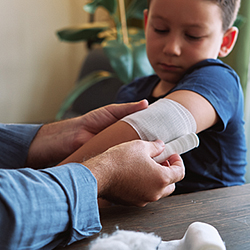
No matter your age or lifestyle, cuts, scrapes, and other open wounds are a normal part of life. In fact, in 2019 the Band-Aid brand sold over 42 million units of bandages and first aid tape in just the United States. That volume speaks to the fact that most wounds can be safely tended to at home. The trick is knowing what to do, what products to use, and when to seek medical help.
Dr. Thomas Canto, MD, FACS, Medical Director at Baystate Wound Care Center, says, “The goal of treating any wound is to promote tissue growth and prevent infection. Taking the right precautions and administering first aid properly are essential to helping the body heal in a timely manner, fighting off infection, and minimizing scarring.”
Stock Your First Aid Kit
Key to proper at-home wound care treatment is a properly stocked wound care kit. Canto advises having the following items on hand at all times:
- An elastic bandage wrap
- Dressings, or bandages, in a range of sizes
- Roller bandages
- Gauze pads
- Xeroform gauze
- Antibiotic ointment or petroleum jelly
- Vinyl, nitrile or latex gloves
Canto notes that while many people like to use tape to hold bandages in place, he’s personally not a fan. “Putting tape on the skin can lead to more skin tears during removal, especially among certain populations,” he says. “Given that, I prefer to use roller bandages to hold dressings in place.”
5 steps for treating wounds at home
If you’re faced with treating a wound at home, follow these five steps for the best outcome:
- Wash your hands: Before tending to any wound on yourself or someone else, wash your hands with soap and water. If you have hand sanitizer, use that after washing your hands.
- Stop the bleeding: Using a bandage, apply firm pressure directly to the wound to stop any bleeding. This may take anywhere between one to five minutes depending upon the severity of the wound.
- Clean the wound: Gently wash the area with water and try to remove any debris that may be lodged in the wound. Canto advises not using alcohol or peroxide on open wounds as they can actually kill healthy cells and slow down healing.
- Apply moisturizing ointment: Research shows that keeping a wound moist, not dry, speeds up and promotes healing. After cleaning the wound, apply a thin layer of an antibiotic ointment or petroleum jelly across the surface to keep it moist. If the wound is cleaned well, antibiotic ointment isn’t necessary for proper healing.
- Protect the wound: Apply a bandage or xeroform gauze to the wound and use rolled bandages to hold it in place. The purpose of covering the wound is purely to keep it clean. Avoid wrapping the wound too tightly which could cut off circulation. Be sure to change the bandage at least once a day. If the bandage becomes dirty or wet replace it immediately.
Once the wound is cleaned and bandaged, you want to keep an eye out for any signs of infection. Inspect it daily, noting any redness, increased pain, drainage, warmth or swelling that may indicate an infection. If you suspect an infection has started, contact your doctor.
When to seek medical attention for a wound
While home is where the first aid kit is, not every cut or wound can adequately be treated there. If any of the following are true for the wound you’re facing, contact your doctor or go to your local urgent care or emergency room:
- The wound is deep and jagged
- The wound exposes any fat, tissue, bones, or tendons
- Unable to move parts of the body normally—wiggling your fingers or toes
- Parts of the body are moving that normally don’t
- There’s uncontrolled bleeding
- You’re unable to thoroughly clean the wound
- The wound is from a human or animal bite
- If the wound fails to heal properly—two to four weeks is normal for a standard wound
- You have any comorbidities that may make it hard to fight infection or heal. These include peripheral artery disease, diabetes, and collagen vascular disease.
What to do when wounds won’t heal
In instances where wounds are persistently slow to heal or healing is complicated by other medical problems like diabetes, high blood pressure, or heart disease, Baystate Wound Center can help. Staffed by a multidisciplinary team of physicians and health professionals who use specialized therapies and advanced technologies including bioengineered tissue, and hyperbaric oxygen therapy, the Wound Center works with patients to resolve chronic, non-healing wounds.